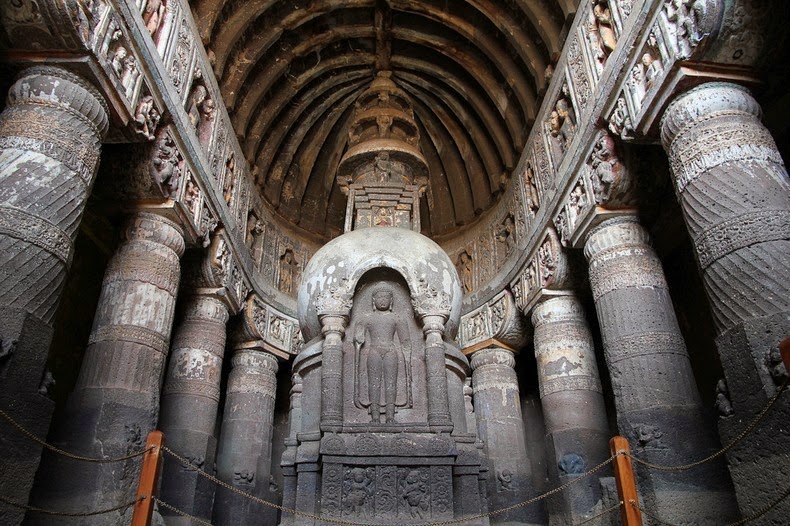The Ajanta and Ellora Caves of India
Ajanta Caves


Ajanta Caves

Ajanta and Ellora are two monumental rock cut caves that define Indian art and architectural accomplishment. Though these two monuments are separated by a distance of approximately 100 kilometers they are often mentioned together since their aesthetics and importance are at par and the fact that both are situated in the Aurangabad district of Maharashtra.
While Ajanta is mostly about beautiful paintings made on cave walls on the theme of Buddhism, Ellora is all about sculpture and architecture belonging to three different religions of those times, prevailing in the country - Buddhism, Hinduism and Jain.
Above Photo credit
Ajanta is a cluster of 30 caves of different sizes excavated in a horse shoe shaped stretch of rock embedded in a hill facing a narrow stream called Waghora. Each cave was connected to the stream by a flight of steps, which are now demolished with few remnants left behind. These caves are named after a nearby village called Ajanta. It includes masterpiece paintings of Buddhist religious art, with figures of the Buddha and depictions of the stories that tell about the previous lives of the Buddha.
The caves were built in two phases starting around the 2nd century BC, with the second group of caves built around 400–650 AD. Buddhist Monks used to retreat to this serene place during the monsoon, and as they had plenty of time during such retreats they used it for deepening their religious quest through prayer and discussion.
There were two types of caves- Vihara and Chaitya griha. Viharas are monasteries used for living and prayer. These are square halls with small cells along the side walls. These cells were used by the monks for rest and other activities while the central larger square space was for prayer. The front of the vihara is often marked by a colonnaded porch, with another space inside the doors running parallel to the porch. The other types of cave, Chaityagrihas, are halls used for prayers. These are long tunnel like caves with round pillars on both sides. At the end of the cave is placed the stupa, which is a symbol of Lord Buddha.
These caves were abandoned twice. First for a period of nearly 300 years, because the local population had turned mainly Hindu. The caves and its excavation became vibrant again with the succession of the Emperor Harishena of the Vakataka Dynasty but again disrupted by Harisena's death in 477 AD. This time it waited for almost 1,000 years till John Smith, a British officer for the Madras Presidency, accidentally discovered the entrance to Cave No. 10, on 28 April 1819, while hunting tiger. John actually vandalized the walls with his name and date, although this is far from normal eye sight now, as when he wrote it, he was standing on some five foot high rubble that collected itself over hundreds and hundreds of years.
The Ajanta and Ellora Caves of India 

The Ajanta and Ellora Caves of India 

The Ajanta and Ellora Caves of India 

The Ajanta and Ellora Caves of India 

The Ajanta and Ellora Caves of India 

The Ajanta and Ellora Caves of India 

Ellora Caves
Ellora Caves comprises of 34 monasteries and temples, dug side by side in the wall of a high basalt cliff, extending over more than 2 km. The caves were built during the 5th to the 10th century, and represents one of the finest examples of Indian rock-cut architecture.
Ellora has cave temples devoted to Hindu, Buddhist and Jain. The Buddhist caves were one of the earliest structures, created between the 5th and 8th centuries. These structures consist mostly of viharas or monasteries, which were large, multi-storeyed buildings carved into the mountain face, including living quarters, sleeping quarters, kitchens, and other rooms. The most famous Buddhist cave is the Vishwakarma cave, popularly known as carpenter cave.
The Ajanta and Ellora Caves of India 

The Hindu caves were constructed between the middle of 6th century to the end of the 8th century. These caves represent a different style of creative vision and execution skills. Some were of such complexity that they required several generations of planning and co-ordination to complete. The highlight of the all the Hindu caves is the Kailasha, designed to recall Mount Kailash, the abode of Lord Shiva. It looks like a freestanding, multi-storeyed temple complex, but it was carved out of one single rock, and covers an area double the size of Parthenon in Athens. The Kailasha alone took hundred years to get completed.
The Jain caves belong to the last phase of construction at Ellora. The Jain caves are smaller in size but contain some intriguing and detailed art work. Be it the beautifully carved pillars of the Indrasabha, the lotus on its ceiling or the exceptional shrine called chota kailasha or the sculptures of Yakshini and Durga.
The Ajanta and Ellora Caves of India 

The Ajanta and Ellora Caves of India

The Ajanta and Ellora Caves of India 

The Ajanta and Ellora Caves of India 


No comments:
Post a Comment
Note: only a member of this blog may post a comment.